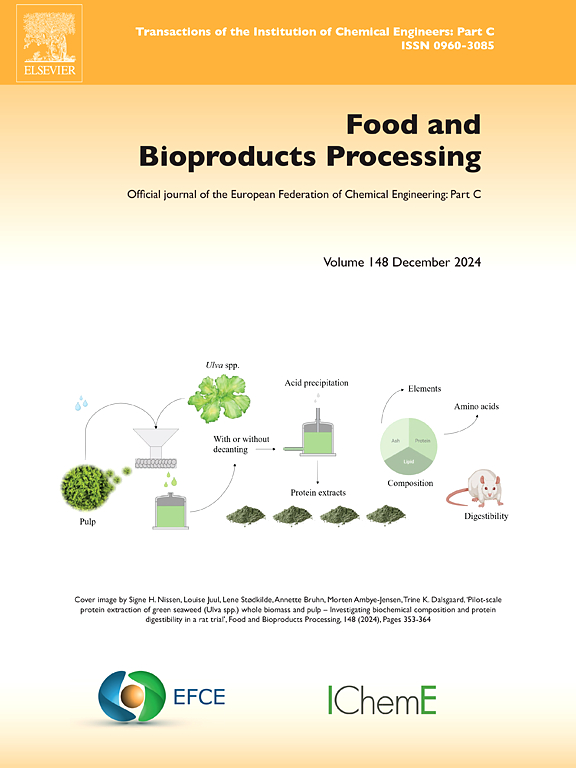亚氯酸钠@柠檬酸对果汁反应抗菌垫的制备及其在冷鲜羊肉中的应用
IF 3.4
2区 农林科学
Q2 BIOTECHNOLOGY & APPLIED MICROBIOLOGY
引用次数: 0
摘要
本研究采用静电纺丝技术,采用逐层叠加的方法制备了果汁反应型抗菌垫。以滤纸纤维(Paper)、聚乙烯醇(PVA)和聚己内酯(PCL)为底物制备果汁响应型抗菌垫。将亚氯酸钠(NaClO2)和柠檬酸(CA)分别装入纸纤维膜和聚乙烯醇纤维膜。电子扫描显微镜、傅里叶红外光谱和水接触角的结果证实了NaClO2和CA分别成功加载到Paper和PVA纤维膜上。响应实验表明,果汁响应型抗菌垫可通过水、NaClO2和CA的反应释放出二氧化氯(ClO2)气体,释放出的ClO2可有效抑制大肠杆菌、金黄色葡萄球菌、铜绿假单胞菌、沙门氏菌和单核增生李斯特菌的生长,抑制率可达99.99 %。将果汁响应型抗菌垫用于冷鲜羊肉的保鲜实验,成功抑制了冷鲜羊肉的微生物数量,延缓了总挥发性碱性氮(TVB-N)和硫代巴比妥酸活性物质(TBARS)的增加,将冷鲜羊肉的保质期延长至21天。本研究为果汁反应型抗菌垫在冷鲜肉保鲜中的应用提供了理论依据。本文章由计算机程序翻译,如有差异,请以英文原文为准。

Preparation of juice-responsive antibacterial pads loaded with sodium chlorite @ citric acid and application in chilled mutton
In this study, a juice-responsive antibacterial pad was prepared by layer-by-layer stacking method using electrostatic spinning techniques. Filter Paper fiber (Paper), polyvinyl alcohol (PVA) and polycaprolactone (PCL) were selected as the substrates for the juice-responsive antibacterial pads. Sodium chlorite (NaClO2) and citric acid (CA) were loaded into paper fibre membrane and PVA fibre membrane respectively. The results of electron scanning microscopy, Fourier infrared spectroscopy, and water contact angle confirmed the successful loading of NaClO2 and CA into the Paper and PVA fiber membranes, respectively. Response experiments demonstrated that the juice-responsive antibacterial pads could release Chlorine dioxide (ClO2) gas through the reaction between water, NaClO2 and CA. The released ClO2 effectively inhibited the growth of Escherichia coli, Staphylococcus aureus, Pseudomonas aeruginosa, Salmonella, and Listeria monocytogenes by up to 99.99 %. Furthermore, the juice-responsive antibacterial pads were applied in preservation experiments with chilled mutton, where the pads successfully inhibited microbial populations, delayed the increase of total volatile basic nitrogen (TVB-N) and thiobarbituric acid reactive substances (TBARS), and extended the shelf life of chilled mutton to the 21st day. This study provided a theoretical basis for the application of juice-responsive antibacterial pads in the preservation of chilled meat.
求助全文
通过发布文献求助,成功后即可免费获取论文全文。
去求助
来源期刊

Food and Bioproducts Processing
工程技术-工程:化工
CiteScore
9.70
自引率
4.30%
发文量
115
审稿时长
24 days
期刊介绍:
Official Journal of the European Federation of Chemical Engineering:
Part C
FBP aims to be the principal international journal for publication of high quality, original papers in the branches of engineering and science dedicated to the safe processing of biological products. It is the only journal to exploit the synergy between biotechnology, bioprocessing and food engineering.
Papers showing how research results can be used in engineering design, and accounts of experimental or theoretical research work bringing new perspectives to established principles, highlighting unsolved problems or indicating directions for future research, are particularly welcome. Contributions that deal with new developments in equipment or processes and that can be given quantitative expression are encouraged. The journal is especially interested in papers that extend the boundaries of food and bioproducts processing.
The journal has a strong emphasis on the interface between engineering and food or bioproducts. Papers that are not likely to be published are those:
• Primarily concerned with food formulation
• That use experimental design techniques to obtain response surfaces but gain little insight from them
• That are empirical and ignore established mechanistic models, e.g., empirical drying curves
• That are primarily concerned about sensory evaluation and colour
• Concern the extraction, encapsulation and/or antioxidant activity of a specific biological material without providing insight that could be applied to a similar but different material,
• Containing only chemical analyses of biological materials.
 求助内容:
求助内容: 应助结果提醒方式:
应助结果提醒方式:


